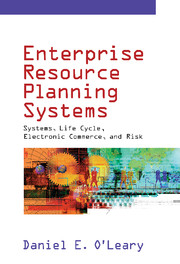14 - ERP and Electronic Commerce
from PART FOUR - ELECTRONIC COMMERCE AND RISK
Published online by Cambridge University Press: 05 June 2012
Summary
Electronic commerce has emerged as a critical aspect of doing business. For many firms there is no separating electronic commerce from regular commerce; the two have become increasingly intertwined. For Cisco, orders over the web have increased from less than 10% in 1996 to roughly 85% in 1999. As a result of these dramatic shifts, there has been an equally dramatic set of changes in the way business is done using electronic commerce. Increasingly, firms such as Cisco are using electronic commerce to simplify their business processes and improve customer relationships (Riggs 1999).
The electronic commerce phenomenon has occurred at roughly the same time as the ERP phenomenon. Further, both are highly dependent on changes in processes to accommodate the new technology, which leads us to ask: “What are some of the relationships between the two?” This chapter explores that question by first establishing ERP as one of the primary building blocks of electronic commerce and then eliciting the role of ERP in each of a number of major electronic commerce initiatives: order tracing, order configuration, order placing, vendor-managed inventories, build to order, and merge in transit.
Building Blocks for Electronic Commerce
What are some of the building blocks for electronic commerce? ERP provides a repository for the information. Communication networks facilitate access to the information. Wide availability and easy-to-use access make it possible to get ERP information over the Internet.
Information
- Type
- Chapter
- Information
- Enterprise Resource Planning SystemsSystems, Life Cycle, Electronic Commerce, and Risk, pp. 195 - 212Publisher: Cambridge University PressPrint publication year: 2000
Accessibility standard: Unknown
Why this information is here
This section outlines the accessibility features of this content - including support for screen readers, full keyboard navigation and high-contrast display options. This may not be relevant for you.Accessibility Information
- 1
- Cited by
